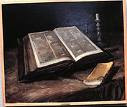
The above da Vinci drawing is titled, "The Virgin and Child with St. Anne and St. John the Baptist." (16th century)
The drawing is now placed in the National Gallery of London.
This drawing has always been a point of contention between art scholars and historians.
Why?
To understand the argument, we must first place the drawing in its historical (literary) context.
St. Anne is the mother of the Virgin Mary and Elizabeth, the mother of John the Baptist. Elizabeth was Mary's cousin thus the connection between the Son of God and the Great prophet.
In the scene depicted, we see St. Anne and the Virgin Mary looking as if one person, seemingly one body.
Mary is on the left and St. Anne on the right with the baby, John the Baptist.
St. Anne is pointing her finger upward towards the heavens, the first of many similar images in da Vinci's work. The baby St. John is seeing something as he looks in the Lord's direction.
It is a curious gaze, as John appeares to be adoring the Son, yet is there more he's seeing?
According to the Mirror of Sacred Scriptures website: guidelines for the placement of mirrors which reveal hidden faces, symbols, and subjects in drawings and paintings during the Renaissance period, as some paintings are rife with symbolism. When placing a mirror towards the sight-line of John the Baptist, reveals an image of extraordinary power and somewhat terrifying. (See below)
Some critics and historians believe the 'man' is wearing a Papal Tiara, which Popes and Cardinals have worn in the late past and continue to wear in prersent time. Other's simply brush this phenomenon off as pure lunacy. However, the image is real and quite distinctive.
Eventually this drawing, a practice session for the genius, became "The Virgin Child with St. Anne." where the Lord reaches for a lamb, and His cousin (John the Baptist) removed from the scene.
This original image was rejected thus the Master re- painted the subject matter to suit the will of his patron.
One is astounded at the amount of symbolism in Renaissance art.
One can sit for hours viewing a print of this time period and spot little gnomes, angels etc, hidden in the bushes or on top of the buildings.
The question we must ask is why "The Virgin and Child and John the Baptist" was rejected for a little less interesting "The Virgin Child with St. Anne" ?
I would venture to say, theological politics had much to do with it.
A wonderful image rife with symbolism.


2 comments:
Hi Midd,
While considering the lovely Burlington House Cartoon, you might also enjoy a friend's article I posted on my own blog site:
http://divertimentodavinci.blogspot.com/
It's called: "Do You See Leonardo's Hidden Penis?" and also contains links with much more on the Virgin and Child with St. Anne and St. John the Baptist.
Thanks Massimo, I'll have a look.
Cheers
Post a Comment